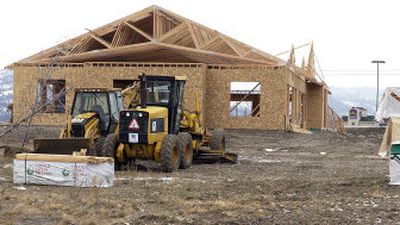Growing at a rapid rate

It’s been only five years since the Liberty Lake became a city, but officials say it is already running out of space.
As the city continues to grow at a rapid rate – previously as much as 17 percent a year – planning director Doug Smith said his department must plan for a possible 15,000 more reside nts.
“Our goal is to get to a level that’s sustainable,” said Smith. “It’s all about balance, and you’ve got to balance your growth against what the impacts are going to be.”
The city has seen its population increase by drastic numbers in the last 15 years. In 1990, the Liberty Lake area had 600 residents. By 2002, it had 4,480 citizens, an increase of 646 percent.
During the city’s formative years, population growth topped out between 17 and 18 percent each year, Smith said. That rate has since slowed, averaging about 10 percent a year recently, which is still faster than any other city in the Spokane and Coeur d’Alene area.
The goal is to get growth down to a manageable 6 percent increase each year, Smith said, which will allow the city to build services and roads fast enough to keep up.
If some Spokane County predictions come true, the city has a lot of work to do.
As part of the Growth Management Act, the county works with various cities and agencies to determine how many people are predicted to move to a given location. This so-called population allocation allows the city and county to plan for growth.
The county allowed Liberty Lake to plan for 15,586 more people by 2026, a task that has given both Smith and some citizen activists a headache for the past six months.
Smith is suggesting that the city expand an Urban Growth Area to the north and south of the city, which would provide homes for an additional 4,350 people. By increasing the density of homes within Liberty Lake, the city could fit in the additional homes needed to house the expected population jump.
But community activist Paul Shields, who lives outside the city on county land surrounding Liberty Lake, said the city has problems that need fixing before it even thinks about adding homes and people.
“The city is at the point now where they need to pull back and say, ‘We grew really quickly, now let’s do some intelligent planning and catch up,’ ” Shields said.
The elementary school in Liberty Lake filled up and now buses kindergarten students to a special center several miles away.
Congestion reaches a boiling point at various intersections in the city, causing long waits. New water rights are at a virtual stand-still as state ecological studies are in progress, causing conservation concerns for the area’s sewer district.
“Those are elements that we, the vast majority of city and county residents, are insisting get taken care of first,” he said.
Smith said new development usually takes care of infrastructure needs, and improvements to the city’s roads are already in progress.
The city is planning a major redesign of the stretch of Liberty Lake Road between Country Vista Drive and Appleway, which will feature a roundabout at one end. Crews also will begin work this summer on repaving some of the city’s 20-year-old neighborhood streets, which are showing wear.
The city is also moving forward with studies on replacing the Greenacres interchange to make it fully accessible, though construction on that project is likely still several years off, Smith said.
New housing projects within the city limits also are still moving along. At the east end of the city, the Rocky Hill development is about half done. A Liberty Village project with 900 housing units may begin construction this year.
And at the north end of the city, construction continues on the River Crossing development, a 3,000-home project that may extend to both the north and south sides of the Spokane River.
Also within the next few years, developers will begin work on retail stores next to Interstate 90. Several retailers have expressed interest in the area so far, Smith said, though none have applied for building permits.